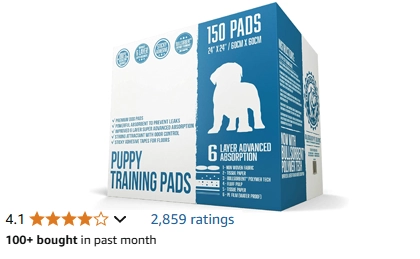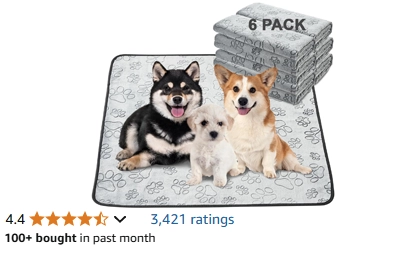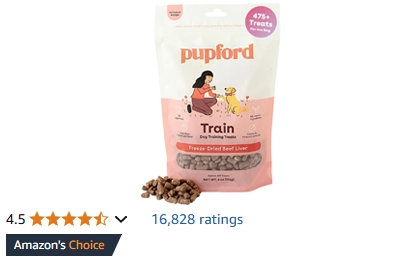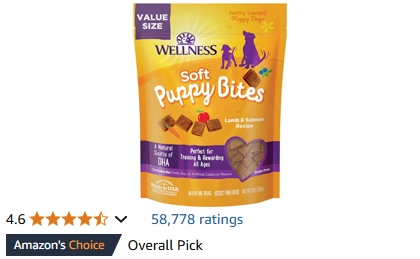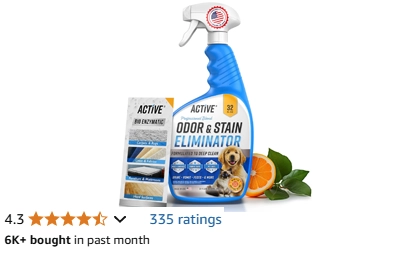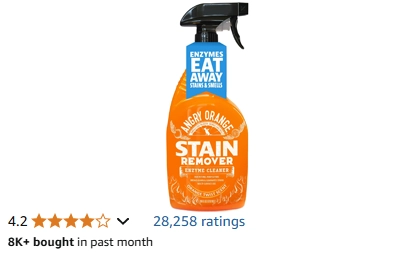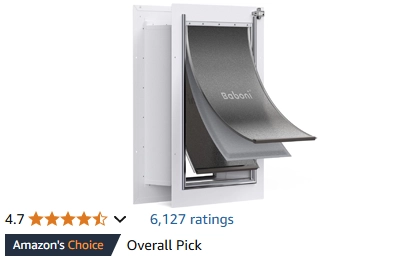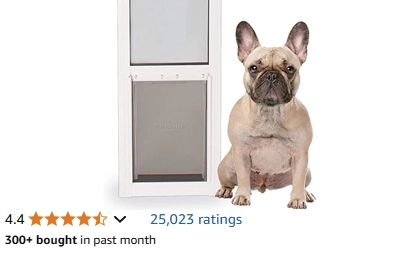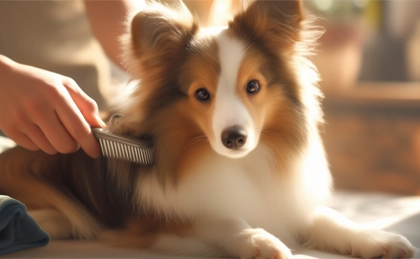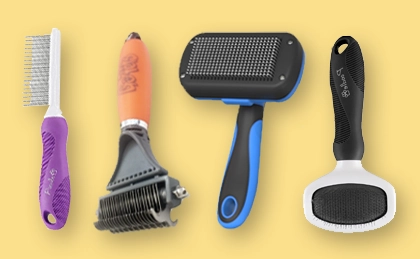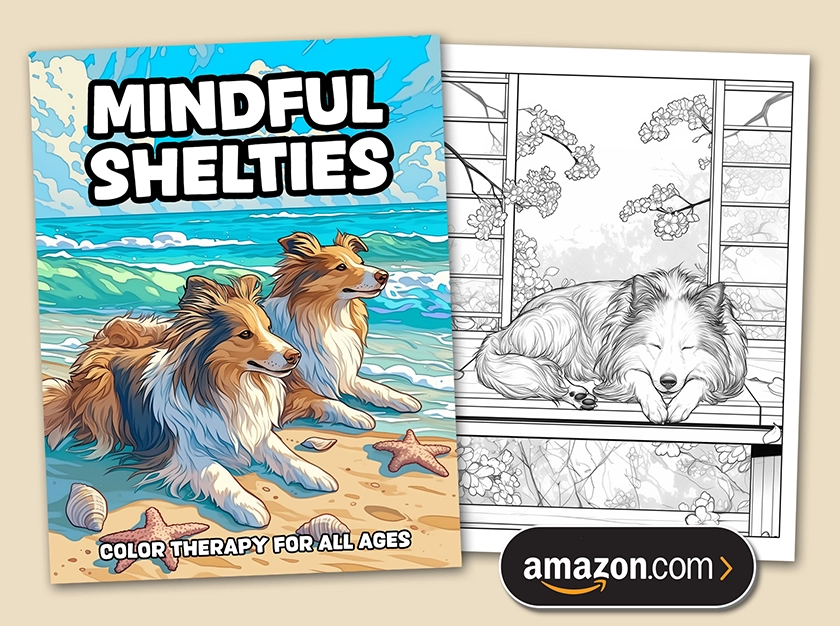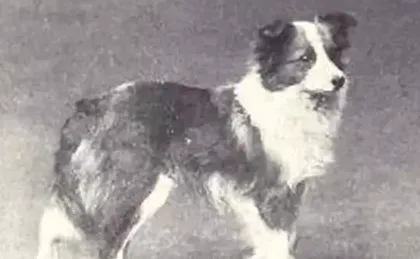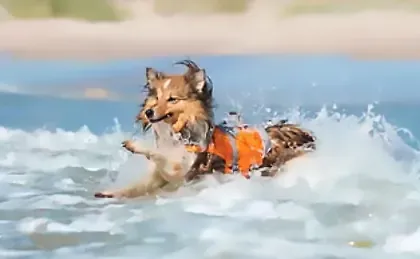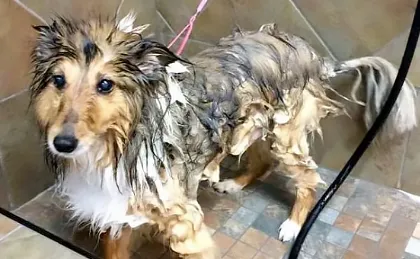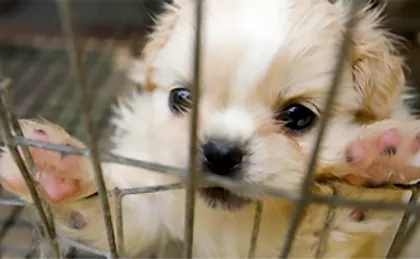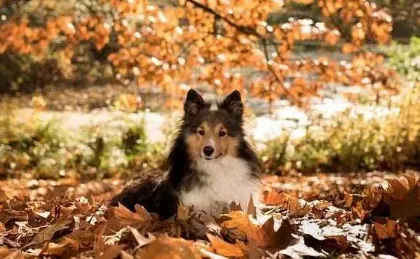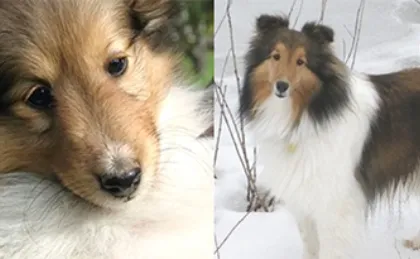House training a Sheltie puppy starts indoors by scenting puppy training pads with their urine and conditioning them to use that same spot every time. From four months old, you can transition their toileting outside using the same pads. Puppy bladders are small and weak so give them the opportunity to go every hour when they're really young, and make sure they have access to the toilet area 24/7. You'll need three things:
#1. Puppy Training Pads
Place a puppy training pad in a designated spot to teach your Sheltie puppy where to pee and poop. For male puppies, keep it away from walls and furniture to prevent spraying. Newspapers work in a pinch, but they do leak and smell bad. During this messy time of your puppy's life, get some decent disposable puppy pads which absorb and crystallize liquid waste to prevent leakage and smells. The sustainable option is washable puppy pads; just buy enough to rotate through your hot wash.
How many pads do you need? This depends on how often your puppy makes it to the pad. More successes means more soiled pads to wash or toss. At first, your pristine puppy pad could last all day. What's more, since dogs are scent-driven, you want to leave a slightly soiled pad out to reinforce the habit. However, once a pad becomes moderately soiled, do replace it as puppies won't toilet on already heavily soiled areas.
#2. Dog Training Treats
Reward your Sheltie when they get it right. Seriously—go wild. The moment your Sheltie successfully eliminates in the designated area, immediately reward them with high-value dog treats, enthusiastic verbal praise, and physical affection. Timing is crucial. Reinforce the behavior within two seconds so they associate the behavior with the reward, whether they did it all on their own or you physically put them there to go.
Research shows positive reinforcement boosts learning 40% faster in dogs. Moreover, behaviors are retained for longer than those acquired through punishment-based methods. (Don't even think about rubbing your dog's nose in it.) Being super smart and eager to please, Shelties respond exceptionally well to rewards-based training. Just rotate the treats for novelty so your puppy doesn't become desensitized, and keep praise enthusiastic while making sure you don't overwhelm them with your rampant ecstasy.
#3. Urine Stain Remover
Puppies have tiny bladders and need to pee every 30–45 minutes at 8 weeks old. By 12 weeks old, they can typically hold it for up to 2 hours, and by 16 weeks, it's closer to 4 hours. However, this isn't just about bladder control—it's about habituating a toilet spot. Since dogs rely heavily on scent cues, it's crucial to eliminate all traces of urine after accidents. Even if you can't always smell it, your puppy's powerful nose can—which strongly prompts him to repeat offend.
Use an enzymatic strain remover that breaks down the uric acid crystals and avoid ammonia-based products as NH3 is a natural component of dog urine, and can actually encourage re-marking. The detective in you may enjoy using a black light to find invisible urine spots that still need treatment.
How to House Train a Sheltie Puppy
Step 1. Indoor House Training (2-4 Months)
Set up a training pad in your new indoor toilet area. This should be well away from where your Sheltie sleeps and eats, which they'll instinctively assign as clean zones. Put pads upstairs and downstairs if you live on multiple floors, because it's not easy to negotiate a full flight of stairs when you're a puppy with a full bladder.
First thing in the morning, put your puppy on the pad and say your chosen toilet command (eg, "go wees" or "busy busy"). This is your best shot to scent the pad as they'll definitely need a morning pee. Repeat this action every hour throughout the day until they start to pee on the pad of their own instinct. Remember:
Conditioning takes time. House training a puppy uses classical conditioning, a technique that requires associations to be built over time. They don't yet know this is their toilet, so when they stray off the pad without peeing, calmly put them back and say your toilet word. Give them lots of opportunities to build those links: toilet word = feeling bladder pressure = peeing on the pad.
Poop after meals. This is trickier but you have a good shot in the 10 minutes or so after they've eaten. Your puppy's full stomach will press on their bowels, giving them the urge to poop. Watch them like a hawk and when you see them sniffing the ground and moving in circles, calmly pick them up and put them on a training pad with the toilet command. Puppies need to poop 4-6 times per day.
Watch for pee signs. Even with frequent potty breaks, Sod's Law means they'll pass up the opportunity to pee on the pad and then pee on the carpet three minutes later. Preempt them by watching for pee signs. Males cock a leg up against a vertical object or simply squat their hind legs down like a female. When you see this cue, carry them to the pad immediately. You will get peed on. But getting just a drop of urine on the pad is a win here. Praise your puppy for any that does land.
Leave some urine on the pads. Don't throw out soiled pads straight away! Yes, it's gross but it makes house training much easier. Your puppy is scent driven and not visually driven like us, so a urine-stained pad is the best cue for telling them where to go next time. While both disposable and washable pads have odor-eliminating technologies, this is for our comfort only. Puppies can still detect residual odors which prompt them to toilet in the same space.
Removea all stains and odors. By the same logic, when your puppy pees in the wrong place remove the stain immediately. Otherwise, it will serve as a scent cue for next time. If you have expensive new carpets, limit your puppy to other areas of the house. Put up a strong mesh baby gate for a few months and save yourself the stress of house-wide pee stains.
Keep cool. This is happening. Expect to feel angry when your puppy boldly pees on the carpet right in front of you. But don't take it out on them—they're not being belligerent, they just don't understand yet. Say a firm "no" when you catch them in the act and gently carry them to the pad. Don't yell at them and certainly don't rub their nose in it as this will damage their trust in you.
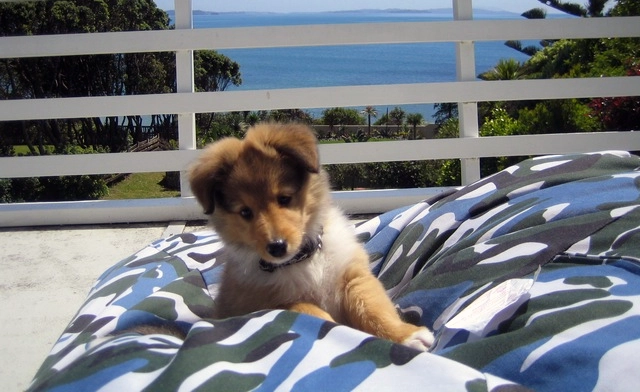
House training a puppy is messy business.
Step 2. Outdoor House Training (4+ Months)
Transition your Sheltie to outdoor toileting from around 4 months old, when they have the physical and mental capacity to get where they need to go. Ideally, your puppy goes on the training pads more often than not by now. This means they're seeing the house as a clean zone. Outdoor house training presents two new obstacles:
Out of sight, out of mind. It's a major leap in cognition for your puppy to consider going elsewhere to pee and poop. So just as you did with indoor house training, repeatedly prompt them to use the new outdoor toilet area every 90-120 minutes during the day.
They can't open doors. Unless you have a dog door installed, or you leave your back door open all day and night, there's now a physical barrier between your Sheltie and their new outdoor toilet area. They need to learn a new skill: how to communicate the need to go out.
Start by conditioning a new association that the toilet is now outdoors. Move the puppy pad outside (but near the door) and tell them all about it. The moment you wake up in the morning, take your pup to the outside pad and wait for them to empty their overnight bladder there. Bring your dog treats with you and lavish pups with praise the second they finish peeing.
Continue to take them out like this every 90-120 minutes throughout the day. Remember, they're more likely to go soon after they eat and during playtimes when they're all excitable. The golden rule is consistency. Offer a frequent toileting routine and note whether they can hold it for the overnight stretch.
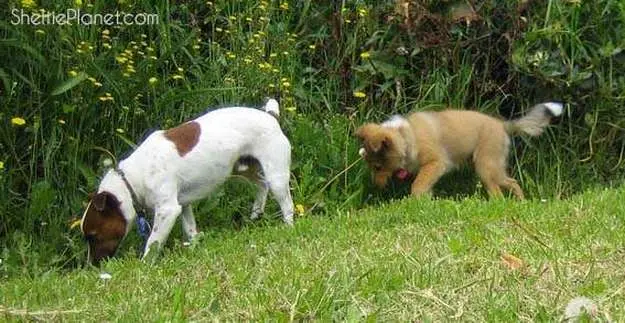
Jock and Howard decide where to pee.
The next thing that happens is just magic. Usually within 1-2 weeks, your Sheltie will internalize the lesson that they're supposed to toilet outdoors. They'll make that cognitive leap, overcoming the problem of the yard being out of sight. At some point they'll feel the urge to pee and take themselves off without any input from you.
What if there's a door in the way? They may just poop right in front of your door, reminding you that you need to leave the door open, install a dog door, or take them outside more frequently. I'm a big fan of dog doors as it gives them the freedom to explore as they please, and there are even rental-friendly options now, like the no-cut dog door that inserts into a sliding glass door frame.
However, without a 24/7 exit, Smart Shelties who understand the house is a clean zone will still find a way to tell you they need to go out. I was blown away when puppy Howard sat at the back door one day and gave a soft but demanding yap! When I opened the door, he shot out and laid a big, friendly package on the grass. Other times, he would scratch the door once and sit politely until we noticed. Eventually we took the hint and gave him his very own dog door. He loved it.
At this stage, you've successfully taught your dog to respect your whole house as a clean zone and communicate their toilet needs. Congratulations—your Sheltie puppy is house trained! Once your Sheltie is truly housebroken you can rely on them to always go outdoors. If not, you know something is wrong. They may be stressed, confused, or sick. As your Sheltie enters their senior years, they may also develop a weak bladder, so prevent indoor accidents by giving them extra-easy outdoor access.
